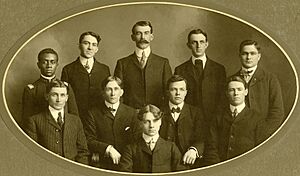Education in Kansas facts for kids
Education in Kansas is managed by different groups. For kids in primary and secondary schools (like elementary, middle, and high school), the rules come from the Kansas State Board of Education. For older students in colleges and universities, the Kansas Board of Regents looks after them.
Contents
Colleges and Universities
The Kansas Board of Regents helps run 37 public colleges and universities in Kansas. They also allow many private schools and schools from other states to operate here. In 2009, the six main public universities had over 93,000 students. Many of these students came from outside Kansas or took classes online.
The University of Kansas (KU) is the biggest university. It has about 26,826 students at its main campus in Lawrence, plus other locations in Overland Park and Topeka. If you include the KU Medical Center, the total is over 30,000 students. About 31% of KU students are from other states.
Kansas State University (KSU) is the second largest. It has about 23,581 students at its campuses in Manhattan and Salina. About 19% of KSU students are from other states. Wichita State University (WSU) is third with 14,823 students. Around 14% of WSU students are from other states.
Other public universities include Fort Hays State University (FHSU), Pittsburg State University (PSU), and Emporia State University (ESU). FHSU has about 11,308 students and is growing fast, especially with students from other states or those taking online classes. PSU has 7,277 students, and ESU has 6,314 students.
You can find a full list of all the colleges and universities in Kansas by checking the complete list.
History of Kansas Colleges
The first colleges in Kansas were started in 1858. The Kansas Territorial Governor, James W. Denver, signed laws to create ten new schools. Three of these schools still exist today in some form.
Highland University (now Highland Community College) and Blue Mont Central College (which became Kansas State University) were among the first. Baker University, started on February 12, 1858, has been open ever since. It is known as the oldest continuously running college in Kansas.
All the colleges founded in 1858 were private schools. The first public university in Kansas was Kansas State University. It was first called Kansas State Agricultural College. The state government created it on February 16, 1863.
Kansas universities were among the first in the country to allow both boys and girls to study together. Kansas State was the second public school to do this when it opened in 1863. Its first class had 52 students: 26 boys and 26 girls. The University of Kansas also started allowing both boys and girls in 1869. Both KU and Kansas State also welcomed students of all races from the very beginning.
Primary and Secondary Schools
School District Changes
Over time, the number of students in small towns across Kansas changed a lot. As farming technology improved, fewer families were needed to work the land. This meant fewer children lived in rural areas. Also, some young men were lost during wars, and many people moved from the countryside to cities. These changes caused rural communities to shrink.
After World War II, in 1945, Kansas passed the School Reorganization Act. This law combined thousands of small, rural school districts, many of which were one-room schoolhouses. Later, in 1963, the School Unification Act combined even more small districts into larger ones called Unified School Districts. This helped schools serve students better with fewer resources.
Brown v. Board of Education of Topeka
One of the most important court decisions in American history happened because of a case in Kansas. This was the 1954 decision in Brown v. Board of Education of Topeka. In this case, the United States Supreme Court said that separating students by race in public schools was against the law.
The lawsuit started in 1951 in Topeka, Kansas. Thirteen parents from Topeka filed a lawsuit against the city's Board of Education. They wanted the school district to stop separating students by race. At the time, an 1879 Kansas law allowed (but did not require) school districts in towns with over 15,000 people to have separate elementary schools for Black and white students.
The parents were helped by leaders from the Topeka NAACP, a civil rights organization. One of the main people in the lawsuit was Oliver L. Brown. He was a parent, a welder, and an assistant pastor. His daughter, Linda Brown, was in third grade. She had to walk six blocks to a bus stop to ride to Monroe Elementary, her segregated Black school, which was a mile away. But Sumner Elementary, a white school, was only seven blocks from her house. This unfair situation led to the famous court case that changed education across the country.


